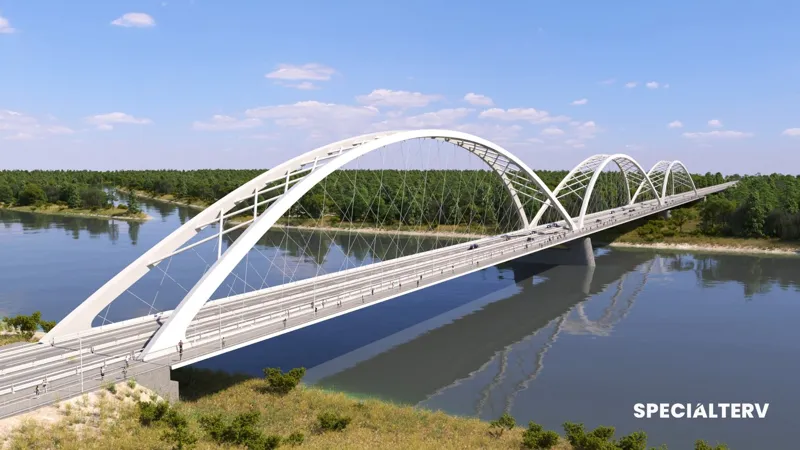After over a century of anticipation and relentless advocacy, the construction of the Mohács Danube Bridge is finally underway, heralding a new era of economic and transportation progress for the city. The dream of a permanent crossing over the Danube has deep roots, tracing back to the mid-19th century when the need for improved connectivity first emerged. Historical events and conflicts have delayed this vision, but in 2024, the project gained new momentum, backed by significant investment and the expertise of Duna Aszfalt Ltd. As this monumental structure rises, it not only symbolizes the triumph of perseverance but also promises to transform the region’s logistical landscape, enhancing trade and community life for generations to come.
| Aspect | Details |
|---|---|
| Project Name | Mohács Danube Bridge |
| Historical Background | Construction dates back to 1687 with temporary bridges for military use. |
| Initial Advocacy | Need for a permanent bridge first expressed in mid-19th century. |
| Key Dates | Project moved forward in 2024, completion expected by 2028. |
| Contractor | Duna Aszfalt Ltd. |
| Historical Significance | The bridge symbolizes economic and transportation development for Mohács. |
| Economic Impact | Will boost local economy and enhance transportation efficiency and safety. |
| Previous Attempts | Multiple attempts to build a bridge since 1906 were halted by wars and crises. |
| Transportation Issues | Residents relied on ferry service with limitations; seasonal disruptions were common. |
| Future Prospects | The bridge is a historic vindication and fulfills a long-standing community vision. |
The Historic Journey of the Mohács Danube Bridge
The journey to construct the Mohács Danube Bridge began long ago, with the first calls for a permanent crossing dating back to the mid-19th century. Despite the early advocacy, various historical events kept pushing the dream further away. Local residents and leaders fought tirelessly for over a century, hoping to replace the unreliable ferry system with a stable bridge that could connect communities and boost trade across the Danube River.
In 2024, after years of delays, the dream finally became a reality with the Ministry of Construction and Transport investing in the project. Duna Aszfalt Ltd. was chosen as the contractor, signaling a new era for Mohács. This bridge is not just a structure; it represents the determination and hard work of a community that has long awaited better connections and economic opportunities.
Mohács’ Strategic Importance Through History
The strategic importance of Mohács stretches back centuries, with its first bridge built in 1687 to aid troops during a military campaign against the Ottomans. This bridge played a vital role in the Battle of Nagyharsány, contributing to a historic victory. Over the years, further military bridges were constructed, underscoring the town’s significance in regional defense and transportation.
During the reign of Joseph II, the need for military transport led to additional bridge projects, cementing Mohács’ role as a key player in the region. This historical context highlights that the desire for a reliable crossing has long been a priority, driven by both military needs and the growth of local trade.
Economic Growth and the Need for Infrastructure
The 19th century brought significant economic growth to Mohács, leading to increased demands for reliable transportation. In 1850, the town gained ferry rights, and by 1857, the Pécs-Mohács railway line was completed, emphasizing the necessity for a steady crossing over the Danube. The local economy thrived on agricultural trade, but the ferry service often proved inadequate, especially during peak seasons.
Farmers and traders faced long waits and congestion during harvest time, with the ferry struggling to keep pace with demand. Additionally, winter conditions frequently halted ferry operations due to ice flows, further complicating trade routes. This highlighted the urgent need for a permanent bridge to support the region’s growing economic activities.
Repeated Delays and Historical Setbacks
Efforts to establish a bridge continued into the early 20th century but faced numerous setbacks. In 1906, local advocates secured support from the Minister of Commerce, and by 1909, initial plans were drafted. Unfortunately, the outbreak of World War I put a stop to these plans, stalling progress on the bridge for decades.
Despite attempts to revive the project between the wars and after World War II, economic crises and shifting priorities consistently derailed efforts. The dream of a permanent crossing was put on hold repeatedly, leaving the community dependent on the unreliable ferry system.
The Modern Era of Transportation Needs
By the late 20th century, the conditions for transportation had drastically changed. As traffic increased, the ferry system became less viable, struggling to meet the growing needs of local residents and businesses. Seasonal disruptions and limited capacity hindered economic opportunities, making it evident that a reliable road link was essential for progress.
The absence of a bridge not only affected daily commutes but also stifled agricultural trade, which relied heavily on timely transport. The local economy faced challenges, and the community’s push for a bridge grew stronger as they sought a solution to their transportation struggles.
A New Beginning: The Bridge Construction Project
In 2024, the Mohács Danube Bridge project finally gained momentum, marking a new beginning for the community. Duna Aszfalt Ltd. was awarded the contract, and construction began, symbolizing hope and determination after a century of waiting. The bridge is expected to be completed by 2028, bringing a long-awaited solution to the town’s transportation issues.
This project is not just about building a bridge; it represents the culmination of over a hundred years of advocacy for better infrastructure. The new bridge will enhance transportation efficiency, promote economic growth, and provide a safe crossing for vehicles and pedestrians alike, fulfilling a dream that has persisted for generations.
Frequently Asked Questions
What is the Mohács Danube Bridge project about?
The Mohács Danube Bridge project is a long-awaited construction aimed at enhancing transportation and economic development in Mohács, marking over 120 years of community efforts for a permanent crossing.
Why was the bridge construction delayed for so long?
The construction faced delays due to historical events, including wars, economic crises, and shifting priorities, which hindered progress from the 19th century to 2024.
Who is responsible for building the Mohács Danube Bridge?
Duna Aszfalt Ltd. is the contractor for the Mohács Danube Bridge, with funding and support from the Ministry of Construction and Transport.
When is the Mohács Danube Bridge expected to be completed?
The bridge is expected to be completed by 2028, providing a vital link for the region.
What economic benefits will the bridge bring?
The bridge will boost local trade, improve transportation efficiency, and enhance safety, supporting agricultural producers and increasing economic opportunities in Mohács.
How did historical events influence the bridge’s construction?
Historical events like wars and political instability repeatedly halted bridge construction efforts, delaying the realization of this crucial infrastructure.
What role did the temporary bridges play in Mohács’ history?
Temporary bridges built in the 17th and 18th centuries were vital for military campaigns and highlighted Mohács’ strategic importance in regional conflicts.
Summary
The Mohács Danube Bridge is an important project that highlights over a century of efforts to improve transportation in the city. Initially proposed in the mid-19th century, the bridge faced many delays due to historical events, including wars and economic crises. In 2024, with support from the Ministry of Construction and Duna Aszfalt Ltd., the project finally began, aiming to enhance local trade and transportation. This bridge, expected to be completed by 2028, symbolizes the determination of the Mohács community and is set to boost the local economy significantly.



